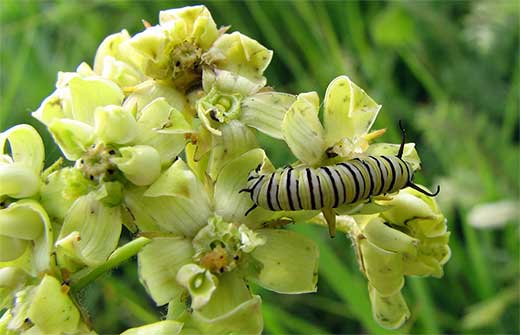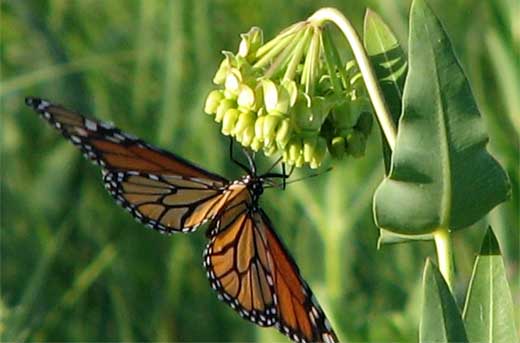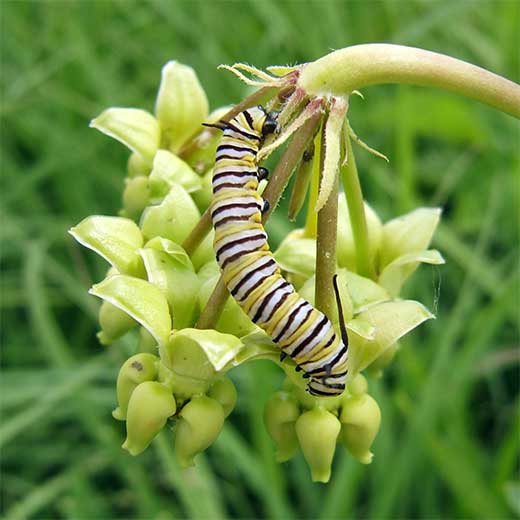Mead’s Milkweed and Monarchs
Thursday, January 20th, 2011 at 2:28 pm by Chip TaylorFiled under Monarch Biology | 3 Comments »
From time to time the question arises as to whether monarchs can and do use all species of milkweeds in the genus Asclepias or whether there are some that are too toxic or have so much latex that larvae are unable to feed properly and die. There could even be some species that lack the chemistry that allows the larvae to even start feeding. Stated another way, it seems possible that some milkweeds might have become as unpalatable to monarchs as they have to other herbivores. It would be valuable to know the answer to this question but we will have to gather more data on what species females chose to lay eggs upon and whether larvae successfully feed and reach the adult stage on a number of species.
There are 72 species of native milkweeds in the genus Asclepias found in the United States. Monarchs use about 30 of these species as host plants with some regularity. Little is known however about the use of many species, particularly the more than 20 that have limited distributions including a number that are rare and endangered. I live in a county (Douglas County, KS) in which 13 species of Asclepias have been recorded. I know locations for 12 of these within the county and have found monarch eggs and larvae on 9 of the 12 species. Two of the three species without eggs or larvae, A. stenophylla (slim leaf milkweed) and A. amplexicaulis (clasping milkweed), are relatively uncommon in the prairie meadows I’ve visited and I’ve always assumed that the lack of evidence of use by monarchs was just a matter of numbers with monarchs simply laying eggs on the most abundant and apparent species. I also knew that monarchs use A. amplexicaulis as a host in other areas.
I reached a similar conclusion with regard to the third species, the rare and endangered Mead’s milkweed, A. meadii. I’ve actually encountered many more plants of this species than of the previous two but again no monarch larvae on any of these plants. Mead’s milkweed is a poor choice as a host, most plants have 6 rather small leaves, the nodding flower-head, if present, is relatively large but overall it seems unlikely that there is enough foliage on a Mead’s milkweed for a single larvae to complete its development. I know better than to speculate that monarch females are smart enough to avoid plants with insufficient foliage but still I had looked at a lot of these plants (hundreds) over the years with nary an egg or larva sighted. So it was with some surprise that I learned that two biologists, Steve Roels (a graduate student at the University of Kansas) and Dr. Retha Meier (Saint Louis University), who study Mead’s milkweed had observed monarch larvae on these plants. I asked Dr. Meier to write up her observations. Here is her report along with two images. Steve Roels provided a third image.
Mead’s Milkweed and Monarchs
By Dr. Retha Meier
Dr. Peter Bernhardt and I began the first season of a three-year study on the pollination of the threatened, Mead’s milkweed (Asclepias meadii) in May 2010. The population we observed grows in a prairie near Garnett, Kansas. Mead’s milkweed is easily overlooked, even where it is common. Each year a plant produces a single, thin, graceful stem that ends in an umbel made up of 5-14 nodding, greenish-colored flowers. Nectar gushes from the horns of these flowers and measures more than 50% dissolved sugar in some flowers. We also discovered that Mead’s milkweed flowers emit an unusually pleasant and spicy fragrance similar to oil of cloves. Nectar and odor must have attracted the monarchs to the dangling blossoms because we watched on numerous occasions as these insects positioned themselves upside-down to drink. While searching for more Mead’s in this diverse prairie we often found it was easier to just follow monarchs to previously unmarked stems in bloom.
One morning while Dr. Bernhardt was measuring floral nectar he discovered that some monarchs were doing something more than drinking. They were laying eggs. He found small stages of the larvae consuming the flowers including the nectar-rich horns. Only one caterpillar was found per umbel but even an early instar, less than 5 mm in length, was capable of doing a considerable amount of damage as it began feeding on the flowers. As flower consumption continued, the small instar grew into a much larger caterpillar that eventually eliminated all the flowers on the umbel. Here we have an example of a much-loved insect spending a most important part of its life-cycle on an increasingly endangered plant. Monarchs didn’t pollinate Mead’s milkweed on the Kansas prairie. Capture and release procedures showed that their mouth-parts and legs were free of the distinctive pollen packets (pollinaria) of their wildflower host. That honor, we’ve learned, belongs to a few, chunky native bees like the Anthophora abrupta.


Steve Roels added the following observations:
Retha’s observations about monarchs on the Welda are similar to my own. Interestingly, monarch herbivory was extremely common on the Welda this year (I believe I saw caterpillars on 10-15 of the 50 stems I was monitoring) but monarchs have been much less frequent on the KU field station Mead’s the last two years. I’m not sure if the difference is due to different butterfly population levels or that plants are easier to find on the Welda because the vegetation is shorter and less dense, making plants easier to find. When caterpillars are present, they can do a tremendous amount of damage, sometimes completely stripping the stem of leaves and buds. They seem to prefer the buds, or perhaps eggs are more frequently oviposited there, and generally the caterpillars work their way from the top of the plant downwards. However, sometimes I have seen caterpillars present one day and then they are gone a few days later, perhaps shuffling off to find a more suitable host plant or getting picked off by some predator. Monarchs did reduce the Welda Mead’s population’s reproductive output to some extent this year but I suspect Cycnia inopinatus is more of a widespread problem for Mead’s.
As far as I know, no one has done any work on the chemical profile of Mead’s as compared to other milkweeds, which could be relevant for a number of herbivores. I considered pursuing this route, but I have plenty of projects as it is. I do wonder if it has lower levels of toxic compounds than other species because deer herbivory at the field station is extremely high in the early spring and I have never seen any deer damage to A. syriaca and only very rarely, if at all, on A. viridis. Some other milkweeds do suffer from the deer including a dense 8’x4′ patch of A. purpurascens that was completely razed last year at the field station.

Additional references for Mead’s milkweed:
http://plants.usda.gov/java/profile?symbol=ASME
http://www.fws.gov/midwest/endangered/plants/pdf/meads-fnl-rp.pdf


3 Responses to “Mead’s Milkweed and Monarchs”
By Flowers on Feb 3, 2011
I have seen caterpillars like this but never knew what they turned into. I know that they can do a lot of damage to flowers and even my vegetables. But afterward they make up for it as butterflies by spreading the pollen and helping to replenish what they have taken. Isn’t nature amazing!
By Clayton on Sep 14, 2011
How much milkweed does the average monarch butterfly eat in a lifetime?
By Alice F. Permenter on Feb 20, 2012
Very interesting observations. I, too, have been curious as to whether some species of Asclepias are preferred over others. I have noticed that even when A. tuberosa is available in my area (MS Delta), the Monarch seem to prefer A. curassavica whenever it is also present. I speculate that the foliage is more tender and palatable on the A. curassavica.